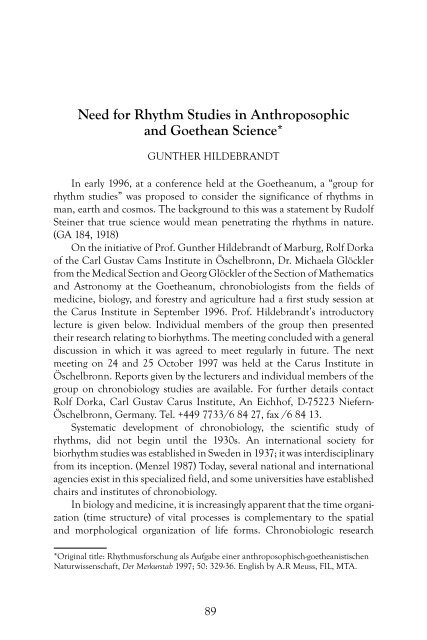When Healing Becomes Educating, Vol. 1 - Waldorf Research Institute
When Healing Becomes Educating, Vol. 1 - Waldorf Research Institute
When Healing Becomes Educating, Vol. 1 - Waldorf Research Institute
You also want an ePaper? Increase the reach of your titles
YUMPU automatically turns print PDFs into web optimized ePapers that Google loves.
Need for Rhythm Studies in Anthroposophic<br />
and Goethean Science*<br />
GUNTHER HILDEBRANDT<br />
In early 1996, at a conference held at the Goetheanum, a “group for<br />
rhythm studies” was proposed to consider the significance of rhythms in<br />
man, earth and cosmos. The background to this was a statement by Rudolf<br />
Steiner that true science would mean penetrating the rhythms in nature.<br />
(GA 184, 1918)<br />
On the initiative of Prof. Gunther Hildebrandt of Marburg, Rolf Dorka<br />
of the Carl Gustav Cams <strong>Institute</strong> in Öschelbronn, Dr. Michaela Glöckler<br />
from the Medical Section and Georg Glöckler of the Section of Mathematics<br />
and Astronomy at the Goetheanum, chronobiologists from the fields of<br />
medicine, biology, and forestry and agriculture had a first study session at<br />
the Carus <strong>Institute</strong> in September 1996. Prof. Hildebrandt’s introductory<br />
lecture is given below. Individual members of the group then presented<br />
their research relating to biorhythms. The meeting concluded with a general<br />
discussion in which it was agreed to meet regularly in future. The next<br />
meeting on 24 and 25 October 1997 was held at the Carus <strong>Institute</strong> in<br />
Öschelbronn. Reports given by the lecturers and individual members of the<br />
group on chronobiology studies are available. For further details contact<br />
Rolf Dorka, Carl Gustav Carus <strong>Institute</strong>, An Eichhof, D-75223 Niefern-<br />
Öschelbronn, Germany. Tel. +449 7733/6 84 27, fax /6 84 13.<br />
Systematic development of chronobiology, the scientific study of<br />
rhythms, did not begin until the 1930s. An international society for<br />
biorhythm studies was established in Sweden in 1937; it was interdisciplinary<br />
from its inception. (Menzel 1987) Today, several national and international<br />
agencies exist in this specialized field, and some universities have established<br />
chairs and institutes of chronobiology.<br />
In biology and medicine, it is increasingly apparent that the time organiz<br />
ation (time structure) of vital processes is complementary to the spatial<br />
and morphological organization of life forms. Chronobiologic research<br />
*Original title: Rhythmusforschung als Aufgabe einer anthroposophisch-goetheanistischen<br />
Naturwissenschaft, Der Merkurstab 1997; 50: 329-36. English by A.R Meuss, FIL, MTA.<br />
89

















